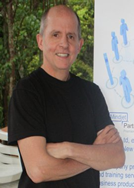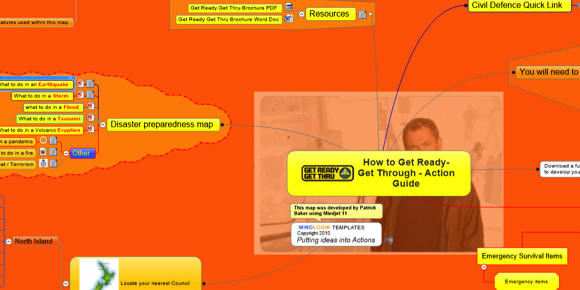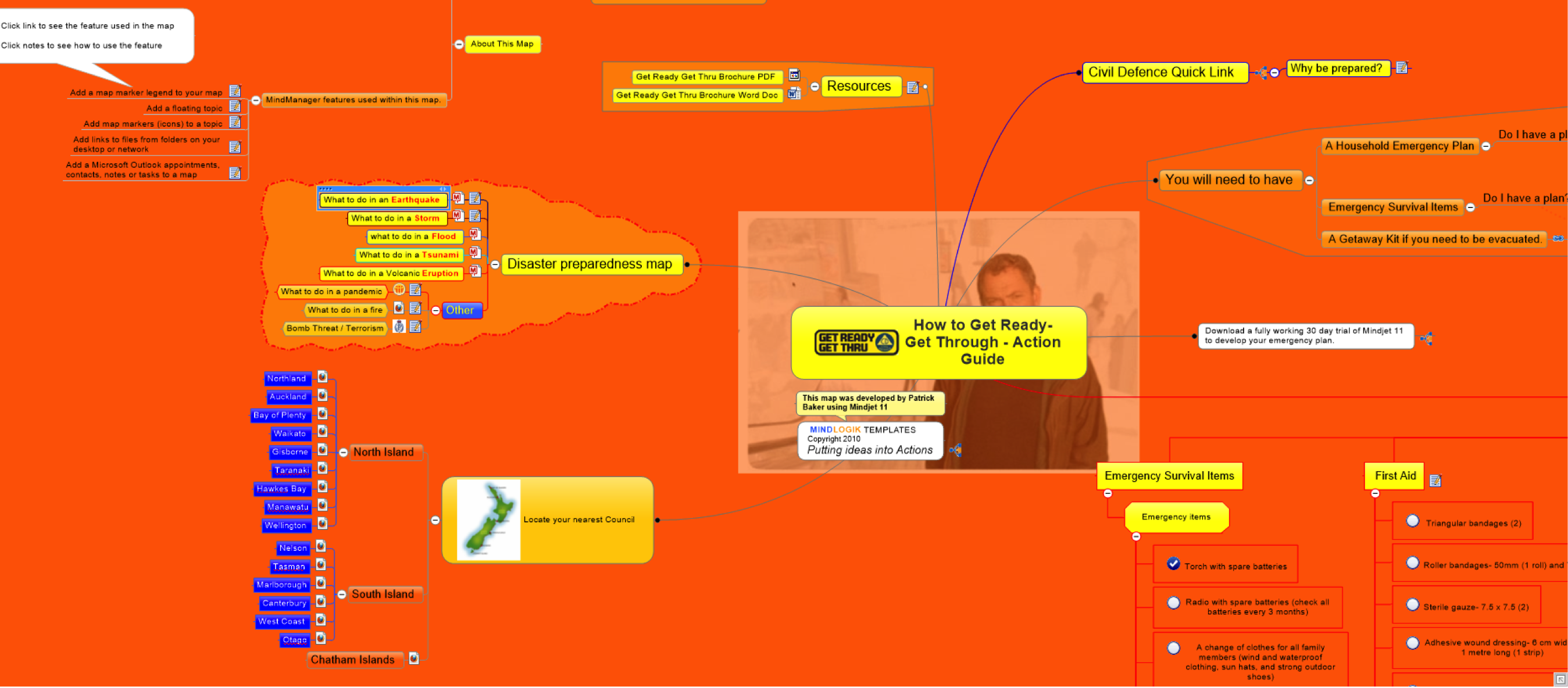 |
|
| Name: Patrick Baker | |
| Title: CEO, Mindlogik Ltd |
|
| Started using Mindjet: 2001 | |
| Social links: Twitter, Facebook, LinkedIn, YouTube, synaptickids.com |
|
How did you hear about Mindjet?
I immigrated to New Zealand with my family in 1997. Up until that stage I had been in various senior management positions in specialized education and after working in Deaf education at the wonderfully dynamic Kelton Deaf Education Centre. I decided I wanted a career change in an Information Technology-related field. As a first step I enrolled at a local Polytechnic called UNITEC , Auckland, to study for a Master’s of Computing degree. For one of my assignments I had to write a comparative study on a particular type of software application and I chose mind mapping software as my assignment topic (not knowing at this time that this would lead me to defining my career change!!).
My assignment concluded that MindManager (Ver 4) was by far the best mind mapping product on the market regarding design, ease of use and was an excellent tool for developing business taxonomies, strategic planning and project management processes. I also started using MindManager for writing assignments and have never been without the product since.
A natural progression was that I approached Mindjet, USA, signed a Partner Agreement and then registered our company, Mindlogik. Eleven years and many software iterations later, and Mindjet is still the software application that underpins our business sales, training and consultancy in the greater Australasian region. Our business focus includes a strong education focus through our subsidiary company called SynapticKids. This includes K1-12 as well as pre and post graduate use of Mindjet as an academic tool.
What do you primarily use it for?
Our core business is Mindjet software sales, support and training in New Zealand. This entails working with commercial, government and academic organisations in developing context-specific Mindjet methodologies and what we call business mapping templates (BMTs). Our approach is to help businesses and organizations capture the essence of their business intellectual capital (the what-makes-you-tick magic of any organization) and to then visualize this as a day-to-day working model for improving productivity based on visually defined business processes and outcomes.
Using Mindjet we focus on four constants in business: Reason for Existence, People, Productivity and Profit. In a nutshell, we work with the people in a business or organization (either individually or in teams) to help them define ways of using Mindjet to drive greater effectiveness specific to their business or organization. Mindjet is implemented across a business, government department or school as a productivity tool that empowers, develops, defines and translates optimal combinations of the four defined business constants using visual Mindjet dashboards unique to delivering outcomes based on their unique raison d’être. This approach naturally led to our company developing Mindjet add-ins that compliment Mindjet functionality and that adds value to legacy and current versions of Mindjet product.
What is your favorite feature?
From a development point of view I must say the API. This places Mindjet way ahead of any competitor and it allows for enhancing Mindjet applications across commercial, government and education markets. In 2012 our company and Nigel Goult from Olympic Limited joined forces by establishing a business partnership called MODi (Mindlogik Olympic Development Initiative). Our business objective is straightforward: to identify and develop add-ins for MindManager legacy and Mindjet current versions that provides ‘Mindjet user wish-list’ functionality and that markets, compliments and supports Mindjet use as a product.
From a user point of view the Brainstorming – to Analysis – to Project View is invaluable in business application as it provides immediate and tangible results for any individual, business or organization using Mindjet as a productivity and systems development tool.
Is there anything the tool helps with that was unexpected?
I have used MindManager extensively through each product release and still jealously guard all of my “original” boxed releases of the product. MindManager X5 was an epiphany of things to come. Over the years of Mindjet product development I have come to appreciate the ability to create template conventions using the Map Theme Organiser and Map Marker Functions. Once developed it is a simple and cost effective process to save these as a library of Professional/Organisational/Process/System Dashboards that are business specific and that directly relate to the four defined constants we use in our business development strategy.
Simply put, it gives me a real buzz to work with an organization (People) to visualize their business vision (Reason for Existence) using Mindjet software functionality (i.e. Brainstorming – to Analysis – to Project View) to maximize both individual and business outcomes (Productivity and Profit). A benefit closely linked to this is the Mindjet export functionality and tight integration with Microsoft Office and the PDF / Mindjet Player. This function on its own saves individuals and organizations so much in time when correctly applied that the cost of the software is negligible compared to tangible and measurable benefits. That is why we predominantly focus our business on training, consultancy and template development contextualized to achieving results.
How does Mindjet help with collaborative processes?
Mindlogik has worked with various companies and organizations across New Zealand to support the use of Mindjet 11, Mindjet Connect and Mindjet Web as a collaborative tool.
Three examples of Kiwi Mindjet ingenuity use come to mind:
Bike New Zealand
BikeNZ uses Mindjet to hone and refine High Performance Plans targeted at winning medals at the Olympics. Their program, backed by Mindjet Connect collaboration software, enables an 18-strong High Performance team of coaches and sports scientists scattered around the world to work on the plan simultaneously.
ABB Group
The ABB Group, a global leader in power and automation technologies, has developed a Loss Map in New Zealand that enables major industrial clients in more than 20 countries to work more efficiently, collaboratively and cost-effectively to save time, improve business processes and drive innovation.. The ABB Loss Map was created by Barry Kleine, an engineer with ABB Process Automation Service, of Rotorua, New Zealand, who is the group’s Global Reliability Manager.
Manurewa Marae
Manurewa Marae is the largest Marae in Auckland, New Zealand set on the shores of Te Manukanuka o Hoturoa (Manukau Harbour). The Marae provides a range of services for Maori that target the well-being of families (whanau) within their community. The services provided target a holistic approach to family (whanau) wellness, to move towards a healthier future.
Lorrainne Byers, the Health Programme Co-ordinator (Pou Whakahaere Kaupapa) for the Manurewa Marae contracted Mindlogik to provide Mindjet training for Marae staff that included the Marae Board of Trustees. The Marae vision and organizational objectives linked to their strategic plan visualize their business vision using Mindjet 11 and Connect Free. This enables greater collaboration between staff in managing Marae projects and keeping Board of Trustees informed of numerous initiatives and project progress outcomes.
Tell us about your map.
One of the maps developed by Mindlogik as a free giveaway is a Civil Defence Map providing information and resources on how to prepare for a natural disaster in New Zealand.
The importance of being prepared for any natural disaster, be it an earthquake, a tornado, a tsunami or a hurricane touched every New Zealander when a magnitude 6.3 earthquake struck the Canterbury region in New Zealand’s South Island at 12:51 pm on Tuesday, 22 February 2011. The Christchurch earthquake was a powerful natural event that severely damaged New Zealand’s second-largest city, killing 185 people in one of the nation’s deadliest peacetime disasters.
Mindlogik developed a Natural Disaster process map using Mindjet 11 based on resources freely available on the New Zealand Civil Defence site.
This map provides a Civil Defence framework that can quite easily be adapted to any country requirements.
[Click for full size image]
Patrick Baker is an experienced business professional and educationalist with over 27 years of experience in teaching, coaching and the application of mind mapping methodologies in business and education. He currently owns and manages Mindlogik Limited and a subsidiary business called Synaptickids. He is also co-founder of the new M.O.D.i, a further source of Mindjet value added resources run in partnership with Nigel Goult of Olympic Limited in the United Kingdom.
—————————————————————————————–
Here at Mindjet, we know the value of sharing ideas. It’s just like philosopher Michel de Montaigne said way back in the 1500s: “It is good to rub and polish our brain against that of others.” The Mindjet User Spotlight series aims to help that little endeavor along by bringing your stories and experiences with Mindjet to the forefront. If you’ve got one to share, don’t be shy! Give us a shout.


